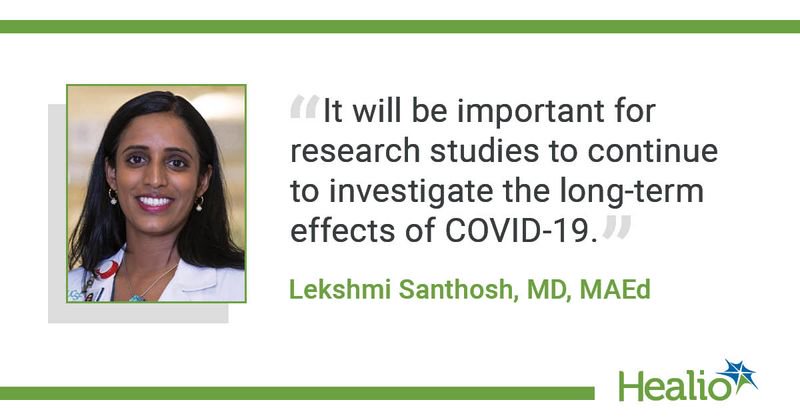Q&A: ‘Structural changes’ to health care systems needed to support COVID-19 ‘long-haulers’
Emerging research has shown that COVID-19 “long-haulers” can face a substantial burden of health loss.
Many patients with persistent COVID-19 are initially asymptomatic.

To support patients with so-called “long COVID-19,” Lekshmi Santhosh, MD, MAEd, assistant professor of medicine at the University of California, San Francisco (UCSF), and colleagues founded the Post-COVID/Post-ICU Multidisciplinary Clinic, which they call the OPTIMAL Clinic.
We spoke with Santhosh about the role of the clinic and the current state of research regarding COVID-19 long-haulers.
Healio: What is the OPTIMAL clinic, and who is it for?
Santhosh: The clinic is for patients who have been hospitalized with COVID-19, as well as patients with prolonged critical illness at risk for post-ICU syndrome.
Healio: What are the most common persistent symptoms experienced by COVID-19 survivors who seek care in the clinic?
Santhosh: Similar to other national and international studies, most of our patients experience persistent symptoms, such as shortness of breath, chest pain, fatigue and weakness/deconditioning.
Healio: The clinic provides care for patients at regular intervals for 12 months after hospitalization. What happens if patients experience symptoms longer than 12 months?
Santhosh: Our clinic started in May 2020, so we do not yet have a lot of data on patients who have had symptoms for longer than 12 months. It will be important for research studies to continue to investigate the long-term effects of COVID-19.
Healio: Is the U.S. health care system set up to care for patients who experience persistent symptoms from COVID-19?
Santhosh: Patients with COVID-19 sometimes experience issues affecting multiple organ systems, and these symptoms may persists for weeks to months depending on multiple factors. There are many issues that make our health care system not set up for success for this. One is that in the United States, medical insurance is often tied directly to employment, so individuals who experience joblessness often lose their insurance and have difficulties accessing health care. Additionally, primary care is the bedrock of a health care system and is not as highly valued as it should be. Therefore, patients with COVID-19 who have difficulties accessing care or who do not have reliable access to primary care often may have limited opportunities to access longitudinal comprehensive care, so this may show up as higher health care utilization in ED visits and hospital readmissions, etc. Moreover, patients with COVID-19 often need integrated pulmonary health care, access to mental health care, access to physical therapy, etc. Delivering all of these services piecemeal is inefficient and can be costly. A streamlined patient-centered system would likely be more beneficial.
Healio: Is there an opportunity here to make reforms in the system that may benefit these patients?
Santhosh: Comprehensive integrated health care with primary care at the bedrock and robust integration of mental health services, as well as decoupling the employment-insurance links, are just two opportunities for improvement. These are much larger structural changes that are needed that will benefit not only the post-COVID patient population, but all patients.

